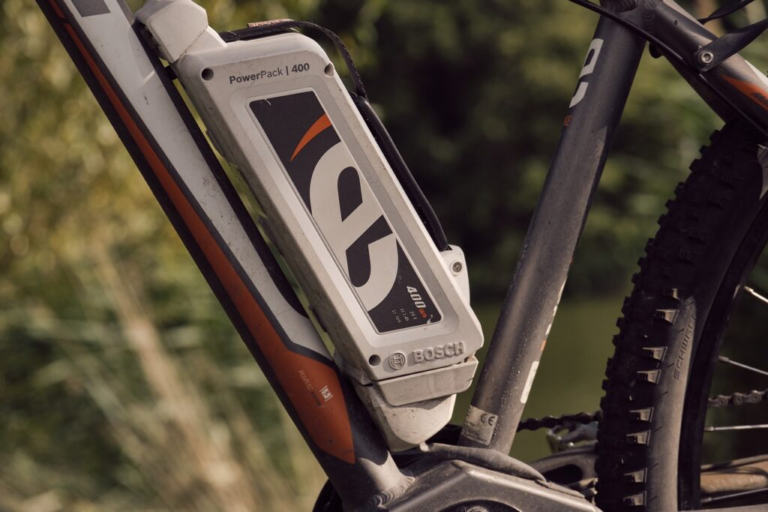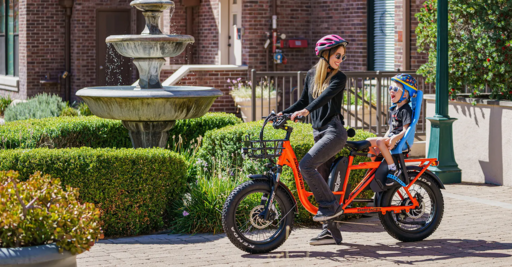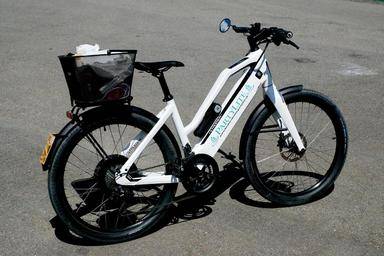Can Fat Tire Electric Bikes Handle Bikepacking or Long Distance Touring?
In recent years, the world of cycling has experienced a profound transformation with the advent of electric bikes, revolutionizing how we approach transportation, recreation, and adventure. Among the diverse array of electric bike options, one particular category has captured the imagination of outdoor enthusiasts and adventurers alike: fat tire electric bikes. These rugged and versatile machines combine the best of both worlds, blending the power of electric propulsion with the stability and traction provided by wide, knobby tires.
The growing popularity of electric bikes stems from their ability to offer a thrilling riding experience while also expanding the horizons of what’s possible in terms of exploration and adventure. Among electric bikes, fat tire models stand out for their exceptional capability to tackle challenging terrain, making them ideal companions for off-road escapades and long-distance journeys into the unknown.
Highlighting the Growing Popularity:
As more cyclists seek to push the boundaries of traditional biking and explore remote trails and rugged landscapes, the appeal of fat tire electric bikes continues to rise. These bikes offer a gateway to off-road adventures that were once considered inaccessible to all but the most intrepid riders. With their robust construction, powerful motors, and oversized tires, fat tire e-bikes empower riders to conquer rough terrain with confidence, opening up a world of possibilities for bikepacking and long-distance touring.
The versatility of fat tire electric bikes extends beyond their off-road prowess. While they excel in navigating gravel paths, rocky trails, and sandy beaches, these bikes are equally capable on paved roads, providing a smooth and efficient ride for urban commuters and recreational cyclists. This adaptability makes fat tire e-bikes a compelling choice for riders seeking a single bike that can handle a wide range of terrain and riding conditions.
In the following sections, we will delve deeper into the potential of fat tire electric bikes for bikepacking and long-distance touring, exploring the key features that make them well-suited for such endeavors and offering practical advice for riders looking to embark on their own adventures. Whether you’re a seasoned bikepacking enthusiast or a curious newcomer eager to explore the great outdoors, join us as we embark on a journey into the world of fat tire electric bike exploration.
Key Takeaways
- Fat tire electric bikes offer enhanced stability and traction, making them ideal for off-road adventures.
- Electric bikepacking and long-distance touring are achievable with the right bike and gear selection.
- Consider factors such as battery range, motor power, and gear capacity when choosing a fat tire e-bike for touring.
- Efficient packing and navigation techniques are crucial for successful bikepacking journeys.
- Safety should always be a priority when riding off-road trails and remote terrain.
- Real-life stories and testimonials can inspire and inform your own bikepacking adventures.
- Embrace the sense of freedom and exploration that comes with touring on a fat tire electric bike.
Understanding Fat Tire Electric Bikes
Defining Fat Tire Electric Bikes:
Fat tire electric bikes, often referred to as “fat e-bikes,” are a specialized category of electric bicycles distinguished by their oversized, wide tires. These tires typically measure between 3.8 to 5 inches in width, significantly broader than the tires found on traditional bicycles. Paired with an electric motor and battery system, fat tire e-bikes offer riders a powerful and versatile means of transportation and exploration.
Unique Features:
- Wide Tires: The defining feature of fat tire electric bikes is, of course, their wide tires. These tires provide several distinct advantages, including increased stability, enhanced traction, and improved shock absorption. The generous surface area of fat tires allows riders to confidently navigate a variety of terrain types, from gravel roads and rocky trails to sandy beaches and snowy paths.
- Electric Propulsion: In addition to their oversized tires, fat tire e-bikes are equipped with electric motors and battery systems that provide pedal-assist or full throttle propulsion. This electric assistance amplifies the rider’s pedaling power, making it easier to tackle hills, headwinds, and long distances without exerting excessive effort.
Enhanced Stability, Traction, and Comfort:
The combination of fat tires and electric assistance creates a winning formula for stability, traction, and comfort, particularly when riding on rough or uneven terrain. Here’s how fat tires enhance the riding experience:
- Stability: The wide footprint of fat tires distributes the rider’s weight over a larger surface area, resulting in increased stability and balance, especially on loose or slippery surfaces. This stability inspires confidence, allowing riders to tackle challenging trails and obstacles with greater ease.
- Traction: The aggressive tread patterns found on fat tire e-bikes provide exceptional traction, allowing riders to maintain control and grip on various surfaces, including mud, sand, gravel, and snow. This enhanced traction is essential for off-road adventures where maintaining momentum and control is paramount.
- Comfort: Fat tires act as natural shock absorbers, smoothing out bumps and vibrations from rough terrain and providing a more comfortable ride experience. This cushioning effect reduces fatigue and discomfort, allowing riders to stay in the saddle for longer periods without sacrificing comfort or performance.
Fat tire electric bikes combine the stability and traction of wide tires with the added power and efficiency of electric propulsion, making them ideal companions for off-road exploration, bikepacking adventures, and long-distance touring. Whether traversing rugged trails or cruising along scenic routes, fat tire e-bikes offer a thrilling and versatile ride experience for cyclists of all skill levels.
RELATED CONTENT – Exploring How Electric Bikes Handle Different Terrain
RELATED CONTENT – Best Electric Bikes for Hills
Exploring the Potential: Electric Bikepacking and Long-Distance Touring
Fat tire electric bikes open up a world of possibilities for adventurers seeking to embark on bikepacking expeditions and long-distance tours. With their unique combination of rugged durability, electric propulsion, and cargo-carrying capacity, these bikes are perfectly suited for tackling the challenges of off-road exploration and extended journeys into the wilderness.
Unlocking New Horizons:
- Extended Range: One of the most significant advantages of using fat tire electric bikes for bikepacking and long-distance touring is their extended range capabilities. Equipped with high-capacity battery systems, these bikes can cover impressive distances on a single charge, allowing riders to explore remote trails and scenic routes without worrying about running out of power. The ability to travel farther and faster opens up a wide range of destinations and itineraries, from multi-day wilderness excursions to cross-country odysseys.
- Pedal-Assist Capabilities: Fat tire e-bikes feature pedal-assist technology, which provides riders with an extra boost of power when pedaling. This pedal-assist functionality makes it easier to conquer steep inclines, headwinds, and rough terrain, allowing riders to maintain a comfortable pace and conserve energy over long distances. Whether tackling challenging ascents or navigating technical trails, the assistance provided by the electric motor enhances the riding experience and enables cyclists to push their limits further than ever before.
- Cargo-Carrying Capacity: Another key benefit of fat tire electric bikes for bikepacking and touring is their ample cargo-carrying capacity. These bikes are designed to accommodate racks, panniers, and other storage solutions, allowing riders to carry essential gear, supplies, and provisions for extended journeys. From camping equipment and food supplies to clothing and navigation tools, fat tire e-bikes provide ample space for stowing all the essentials needed for a self-supported adventure in the wilderness.
Enhancing the Adventure:
Using fat tire electric bikes for bikepacking and long-distance touring opens up a world of adventure and exploration, offering riders the freedom to roam off the beaten path and immerse themselves in the beauty of the natural world. Whether traversing rugged mountain trails, winding through dense forests, or following scenic coastal routes, fat tire e-bikes provide a thrilling and immersive ride experience that brings cyclists closer to nature and ignites a sense of wonder and discovery.
Fat tire electric bikes offer unparalleled versatility and performance for bikepacking and long-distance touring, allowing riders to explore remote wilderness areas, conquer challenging terrain, and embark on epic adventures with confidence and ease. With their extended range, pedal-assist capabilities, and cargo-carrying capacity, these bikes empower cyclists to push their limits, expand their horizons, and create unforgettable memories on the open road.
RELATED CONTENT – Enhancing the Comfort of Long Electric Bike Rides
RELATED CONTENT – Lightweight Ebikes for RV Travel
Selecting the Right Fat Tire E-Bike for Your Adventure
Key Considerations:
When embarking on a bikepacking or touring adventure with a fat tire electric bike, selecting the right bike is essential to ensure a safe, comfortable, and enjoyable ride. Here are key factors to consider:
- Battery Range: Evaluate the battery range of the fat tire e-bike, which indicates how far you can travel on a single charge. For long-distance touring, opt for a bike with a higher battery capacity to minimize the need for frequent recharging. Look for lithium-ion batteries with larger capacities (measured in watt-hours) for extended range capabilities.
- Motor Power: Consider the motor power of the e-bike, which determines the level of assistance provided when pedaling. Look for mid-drive motors with sufficient torque for tackling steep inclines and rough terrain. Higher wattage motors offer more power, enabling smoother acceleration and better performance on challenging trails.
- Frame Design: Choose a fat tire e-bike with a sturdy and durable frame design optimized for bikepacking and touring. Look for features such as reinforced welds, integrated cable routing, and mounting points for racks and accessories. A modular frame design allows for easy customization and adaptability to different riding styles and terrain conditions.
Tips for Customizations and Accessories:
Enhance your bikepacking experience by customizing your fat tire electric bike with the following accessories:
- Cargo Racks and Panniers: Install front and rear cargo racks to increase your bike’s carrying capacity and transport essential gear and supplies. Attach waterproof panniers or saddlebags for storing clothing, camping equipment, and food supplies securely.
- Fenders and Mudguards: Invest in fenders and mudguards to protect yourself and your bike from mud, water, and debris kicked up by the fat tires. Choose lightweight and durable options designed specifically for fat tire e-bikes to ensure proper fit and functionality.
- Lights and Reflectors: Equip your bike with powerful front and rear lights and reflective accessories to enhance visibility and safety, especially when riding at night or in low-light conditions. Choose rechargeable LED lights with multiple brightness settings for versatility and long-lasting performance.
- GPS Navigation System: Install a GPS navigation system or smartphone mount to help you navigate unfamiliar routes and trails with ease. Choose a waterproof and shock-resistant device with preloaded maps and route planning features for added convenience and peace of mind.
- Comfort Upgrades: Consider upgrading your bike’s saddle, grips, and handlebars for increased comfort during long rides. Choose ergonomic designs with cushioning and adjustable features to reduce fatigue and prevent discomfort.
By carefully selecting the right fat tire e-bike and customizing it with the appropriate accessories, you can optimize your bikepacking and touring experience and enjoy the freedom of exploring remote trails and rugged landscapes with confidence and ease.
RELATED CONTENT – Review of the Swagtron Foldable Fat Tire Electric Bike
RELATED CONTENT – Fat Tire Electric Tricycle
Gear Essentials for Fat Tire Electric Bikepacking
Essential Gear and Accessories:
When preparing for a bikepacking adventure with a fat tire electric bike, having the right gear and accessories is crucial for a successful and enjoyable trip. Here are some essentials to consider:
- Lightweight Camping Equipment: Opt for compact and lightweight camping gear to minimize bulk and weight on your fat tire e-bike. Choose a lightweight tent, sleeping bag, and sleeping pad designed for backpacking to save space and reduce the overall load. Consider multi-functional gear, such as a lightweight camping stove with collapsible cookware, to maximize efficiency without sacrificing functionality.
- Bike Racks and Cargo Bags: Invest in sturdy and reliable bike racks and cargo bags to increase your bike’s carrying capacity and transport essential gear and supplies. Choose front and rear racks designed specifically for fat tire e-bikes, with secure mounting systems and ample cargo space. Select waterproof and durable panniers, saddlebags, or frame bags to protect your belongings from the elements and ensure safe transport during the journey.
- Navigation Tools: Pack navigation tools such as maps, compasses, and GPS devices to help you navigate unfamiliar routes and trails with confidence. Consider downloading offline maps and route planning apps on your smartphone for real-time navigation assistance, even in remote areas without cellular coverage. Bring spare batteries or portable chargers to keep your electronic devices powered throughout the trip.
- Repair and Maintenance Kit: Prepare a comprehensive repair and maintenance kit to address common issues and emergencies that may arise during your bikepacking adventure. Include essential tools such as tire levers, patch kits, multi-tools, spare tubes, and a portable bike pump to handle minor repairs and adjustments on the go. Familiarize yourself with basic bike maintenance techniques, such as fixing flat tires and adjusting brakes, to ensure a smooth and trouble-free ride.
Packing Efficiently for Long-Distance Touring:
Packing efficiently is essential for long-distance touring on fat tire electric bikes, as it maximizes storage space and minimizes unnecessary weight. Here are some tips for packing efficiently:
- Prioritize Essentials: Identify essential items such as clothing, food, water, and safety gear, and pack them first to ensure they are readily accessible during the ride. Consider the duration and intensity of your trip when determining the quantity of supplies to bring and prioritize lightweight and compact options whenever possible.
- Organize Gear Strategically: Organize your gear strategically to distribute weight evenly and optimize balance and stability while riding. Pack heavier items closer to the bike’s center of gravity and distribute weight evenly between the front and rear racks to maintain control and maneuverability on varied terrain.
- Minimize Redundancy: Minimize redundancy by selecting versatile gear and clothing that can serve multiple purposes and eliminate unnecessary duplicates. Consider layering clothing for temperature regulation and bringing multi-functional tools and equipment to save space and weight.
- Streamline Packing Process: Streamline the packing process by using compression sacks, stuff sacks, or dry bags to condense bulky items and maximize storage space. Utilize the available storage compartments on your bike, such as frame bags, handlebar bags, and seat packs, to distribute weight efficiently and reduce wind resistance while riding.
By carefully selecting essential gear and accessories and packing efficiently for long-distance touring on fat tire electric bikes, you can optimize your bikepacking experience and enjoy the freedom of exploring remote trails and rugged landscapes with confidence and ease.
Navigating Off-Road Terrain: Tips and Techniques:
Riding Techniques for Off-Road Terrain:
When venturing off-road with your fat tire electric bike, mastering the following riding techniques will help you navigate challenging trails and remote terrain with confidence:
- Body Positioning: Maintain a balanced and centered position on your bike, with your weight distributed evenly between the front and rear wheels. Keep your knees and elbows slightly bent to absorb shocks and maintain stability over rough terrain.
- Cadence Control: Adjust your pedaling cadence to match the terrain and maintain momentum while climbing steep inclines or descending technical sections. Shift to lower gears for uphill climbs and higher gears for downhill descents to optimize efficiency and control.
- Braking Technique: Use a combination of front and rear brakes to modulate speed and control descent on steep or slippery terrain. Apply gentle pressure to both brakes simultaneously, favoring the rear brake slightly to prevent skidding and maintain traction.
- Line Selection: Choose the smoothest and most stable line through obstacles such as rocks, roots, and mud puddles to minimize resistance and maintain momentum. Look ahead and anticipate changes in terrain to adjust your line and avoid potential hazards.
Navigation Strategies for Remote Terrain:
Navigating off-road trails and remote terrain requires careful planning and preparation to ensure a safe and enjoyable ride. Consider the following navigation strategies:
- Trail Research: Conduct thorough research on the trail conditions, difficulty level, and potential hazards before embarking on your ride. Consult trail maps, guidebooks, and online resources to familiarize yourself with the route and identify key landmarks and waypoints along the way.
- GPS Navigation: Use GPS navigation devices or smartphone apps with offline maps to track your progress and navigate unfamiliar trails with confidence. Download maps and route data in advance and carry a backup navigation device or printed maps as a precaution in case of battery failure or signal loss.
- Wayfinding Skills: Develop basic wayfinding skills such as map reading, compass navigation, and orienteering to navigate off-road terrain without relying solely on electronic devices. Learn how to interpret topographic maps, identify natural landmarks, and use compass bearings to determine direction.
- Trail Markings and Signs: Pay attention to trail markings, signs, and trail blazes to stay on course and avoid getting lost in unfamiliar terrain. Familiarize yourself with common trail symbols and markings used to indicate trail difficulty, direction, and points of interest along the route.
Safety Considerations and Preparation:
When riding off-road trails and remote terrain, prioritize safety and be prepared for unexpected challenges with the following precautions:
- Emergency Supplies: Carry essential safety equipment and emergency supplies, including a first aid kit, multitool, spare tubes, tire repair kit, and extra water and food rations. Prepare for potential emergencies such as injuries, mechanical breakdowns, or inclement weather by carrying a lightweight emergency shelter, signaling devices, and a charged cell phone or satellite communicator for communication.
- Weather Awareness: Stay informed about current weather conditions and forecasts for your destination and be prepared for changing weather patterns, especially in mountainous or remote areas. Dress appropriately for the conditions and bring extra layers of clothing, rain gear, and protective accessories such as gloves, sunglasses, and sunscreen to stay comfortable and protected from the elements.
- Group Riding Protocol: If riding in a group, establish clear communication and safety protocols to ensure everyone’s well-being and coordinate assistance in case of emergencies or mechanical issues. Maintain a safe distance between riders and communicate any hazards or obstacles encountered on the trail to prevent accidents and minimize risk.
- Trail Etiquette: Respect trail etiquette and environmental guidelines to minimize your impact on the natural surroundings and preserve the integrity of off-road trails for future generations. Stay on designated trails, avoid disturbing wildlife, and pack out all trash and waste to leave no trace of your presence in the wilderness.
By mastering riding techniques, employing effective navigation strategies, and prioritizing safety considerations and preparation, you can confidently navigate off-road terrain and embark on memorable adventures with your fat tire electric bike. Remember to stay vigilant, adapt to changing conditions, and embrace the challenges and rewards of exploring remote trails and rugged landscapes.
Real-Life Adventures: Stories and Testimonials:
Embarking on bikepacking or touring adventures with fat tire electric bikes often leads to unforgettable experiences filled with discovery, challenge, and connection with nature. Here are inspiring stories and testimonials from riders who have explored remote trails and rugged landscapes with their fat tire e-bikes:
1. Embracing the Wilderness:
Jessica, an avid outdoor enthusiast, shares her exhilarating journey through the backcountry trails of the Pacific Northwest. With her trusty fat tire electric bike in tow, she navigated through dense forests, crossed rushing streams, and summited breathtaking mountain passes. “Riding through the wilderness on my fat tire e-bike was like experiencing freedom in its purest form,” Jessica recalls. “The electric assistance gave me the power to conquer any terrain, while the wide tires provided stability and traction on even the most challenging trails. Every twist and turn revealed a new adventure, and every summit offered a panoramic view of the untamed wilderness below. It was a journey of self-discovery, resilience, and awe-inspiring beauty that left me longing for more.”
2. Connecting with the Elements:
Mark and Sarah, a couple passionate about outdoor exploration, embarked on a cross-country bikepacking adventure with their fat tire electric bikes. From the rugged coastlines of California to the towering peaks of the Rocky Mountains, they immersed themselves in the awe-inspiring beauty of nature. “Riding through diverse landscapes and changing climates allowed us to connect with the elements in a profound way,” Mark reflects. “Our fat tire e-bikes carried us effortlessly over sand dunes, rocky trails, and gravel roads, providing a sense of freedom and exploration unlike anything we’ve experienced before. Each day brought new challenges and triumphs, but it was the moments of quiet reflection beneath starlit skies and the camaraderie shared around campfires that left a lasting impression. Our journey was not just about reaching the destination; it was about embracing the journey itself and savoring every moment of our adventure.”
3. Rediscovering the Joy of Exploration:
Tyler, a seasoned cyclist, rediscovered his love for exploration while bikepacking through the rugged terrain of the Southwest desert. “As a long-time cyclist, I thought I had seen it all, but nothing prepared me for the exhilarating experience of bikepacking with a fat tire electric bike,” Tyler shares. “The combination of electric assistance and wide tires transformed my perception of what’s possible on two wheels. I found myself venturing off the beaten path, exploring hidden canyons, and discovering remote oases that seemed untouched by time. Riding through the vast desert landscape under the blazing sun, I felt a sense of liberation and empowerment that renewed my passion for adventure. With each pedal stroke, I embraced the joy of exploration and the thrill of uncovering hidden gems in the wilderness.”
Highlighting the Sense of Freedom, Exploration, and Connection with Nature:
These stories and testimonials highlight the profound sense of freedom, exploration, and connection with nature experienced by riders on their fat tire electric bikepacking or touring adventures. Whether traversing rugged trails, summiting mountain passes, or meandering through remote landscapes, fat tire e-bikes offer a gateway to unparalleled adventures and unforgettable experiences. The electric assistance provides the power to conquer any terrain, while the wide tires offer stability and traction, enabling riders to explore new horizons with confidence and ease. Each journey is a celebration of the natural world and a reminder of the transformative power of outdoor exploration.
FAQs
The range of fat tire electric bikes varies depending on factors such as battery capacity, motor efficiency, terrain, and rider weight. On average, fat tire e-bikes can travel between 20 to 80 miles on a single charge, with some high-capacity models exceeding 100 miles under optimal conditions.
Yes, fat tire electric bikes are well-suited for mountainous terrain due to their wide tires, which provide enhanced traction and stability on uneven surfaces. The electric assistance also helps riders conquer steep climbs and navigate rugged trails with ease, making fat tire e-bikes a popular choice for mountain biking adventures.
Yes, most fat tire electric bikes are equipped with mounting points for attaching panniers, cargo racks, and other accessories. These attachments allow riders to increase their bike’s carrying capacity and transport gear and supplies for bikepacking or touring adventures.
While fat tire electric bikes require similar maintenance as traditional bicycles, there are some additional considerations due to the electric components. Regular maintenance tasks include checking tire pressure, lubricating the chain, inspecting brakes, and cleaning the bike. Additionally, it’s important to periodically check and maintain the battery, motor, and electrical connections as recommended by the manufacturer.
Yes, there are various types of fat tires designed for specific terrain conditions. For example, knobby tires with aggressive tread patterns are suitable for off-road trails and muddy terrain, while smoother tires with less aggressive tread are better suited for paved roads and urban commuting. Riders can choose tires based on their preferred riding style and the type of terrain they plan to encounter.
Pedal-assist mode on fat tire electric bikes provides additional power to assist the rider’s pedaling effort. Sensors detect the rider’s pedaling cadence, torque, or speed and automatically engage the electric motor to provide assistance. The level of assistance can typically be adjusted using a control panel or handlebar-mounted display, allowing riders to customize their riding experience based on terrain and desired effort level.
While fat tire electric bikes are designed to support heavier loads than traditional bicycles, they do have weight limitations that vary depending on the bike’s construction and components. Riders should consult the manufacturer’s specifications to determine the maximum recommended weight capacity for their specific model. Additionally, distributing weight evenly and using sturdy cargo racks and panniers can help prevent damage to the bike and ensure a safe and comfortable riding experience.
Using an electric bike for long-distance touring offers several advantages over a traditional bike, including:
Increased range: Electric assistance allows riders to cover longer distances with less physical effort.
Enhanced climbing ability: Electric motors provide extra power for climbing hills and conquering steep terrain.
Reduced fatigue: Electric assistance helps riders maintain a steady pace and reduces fatigue during extended rides.
Versatility: Electric bikes can be used for both leisurely touring and more challenging bikepacking adventures, offering versatility for riders of all skill levels.
Yes, many fat tire electric bikes are equipped with removable batteries that can be recharged using a standard electrical outlet or a portable charger while on the road. Riders can carry spare batteries or recharge their bike’s battery at designated charging stations along their route to extend their range and continue their journey.
The regulations governing the use of fat tire electric bikes on trails and public lands vary depending on local and state laws, as well as land management policies. In general, fat tire e-bikes are subject to the same regulations as traditional bicycles, but some trails and parks may have specific restrictions or designated areas for e-bike use. Riders should familiarize themselves with local regulations and trail etiquette before riding their fat tire e-bikes on public lands to ensure compliance and minimize conflicts with other trail users
Conclusion
In conclusion, the world of fat tire electric bikepacking and long-distance touring offers boundless opportunities for adventure, exploration, and connection with nature. With their rugged construction, powerful electric assistance, and wide tires providing stability and traction, fat tire e-bikes empower riders to conquer challenging terrain and embark on unforgettable journeys into the great outdoors.
From traversing mountainous trails to meandering through remote wilderness areas, fat tire electric bikes provide a unique blend of performance and versatility that opens up a world of possibilities for cyclists of all skill levels. Whether you’re seeking the thrill of off-road exploration or the serenity of a scenic countryside tour, fat tire e-bikes offer a thrilling and rewarding ride experience that will leave you inspired and invigorated.
As you prepare to venture on your own bikepacking or touring adventure with a fat tire electric bike, remember to prioritize safety, plan ahead, and embrace the journey with an open heart and adventurous spirit. With careful preparation and a sense of curiosity and wonder, you’ll discover new horizons, forge lasting memories, and experience the transformative power of outdoor exploration.
Join the Conversation
We’d love to hear about your own fat tire electric bike adventures and experiences! Share your stories, tips, and photos in the comments below, and don’t forget to hit the share button to spread the joy of bikepacking and touring with fellow cyclists and outdoor enthusiasts. Let’s inspire each other to embark on new adventures and explore the world on two wheels together.
External Sources
For additional information and resources on fat tire electric bikepacking and touring, consider exploring the following reputable sources:
- Bikepacking.com: Bikepacking.com is a comprehensive online resource dedicated to the art of bikepacking, offering a wealth of articles, gear reviews, route guides, and trip reports. Whether you’re new to bikepacking or a seasoned adventurer, Bikepacking.com provides valuable insights, inspiration, and practical advice to help you plan your next fat tire electric bikepacking adventure.
- Electric Bike Report: Electric Bike Report is a leading online publication focused on electric bikes, providing in-depth reviews, industry news, and expert insights into the world of e-bikes. With a dedicated section on fat tire electric bikes, Electric Bike Report offers valuable information on the latest models, technology trends, and accessories for bikepacking and long-distance touring.
- Adventure Cycling Association: The Adventure Cycling Association is a non-profit organization dedicated to promoting bicycle travel and adventure. Their website features a wealth of resources for cyclists, including route maps, trip planning tools, and educational materials. Explore their extensive network of bikepacking routes and touring itineraries to discover new destinations and plan your next fat tire electric bike adventure with confidence.
Kristina Grant is not just an enthusiast but a true authority on electric bikes. Nestled in the coastal beauty of Virginia, Kristina has found the perfect backdrop for her passion for electric biking. As a dedicated wife and homeschooling mom, her life revolves around family, faith, and the thrill of adventure.
Originally hailing from Ohio, Kristina's journey with electric bikes began as a curiosity and quickly evolved into a deep expertise. Her blog is a testament to her love for electric biking, combining her fascination for eco-friendly transportation with her coastal lifestyle.
When she's not cruising the beach on her electric bike, you'll find Kristina indulging in her other loves: long walks along the shore, getting lost in a good book, and cherishing moments with her loved ones. With a heart as big as her love for animals, especially cats, Kristina brings a unique perspective to the electric bike world, grounded in her strong faith in God and her dedication to a sustainable lifestyle.
Through her blog, Kristina shares her extensive knowledge of electric bikes, offering valuable insights, tips, and recommendations to fellow enthusiasts. Whether you're a seasoned rider or a newcomer to the electric bike scene, Kristina's blog is your go-to source for all things electric biking, fueled by her passion, expertise, and the scenic beauty of coastal Virginia.







